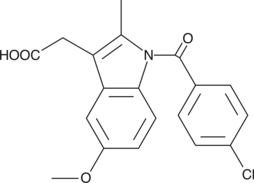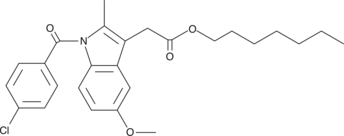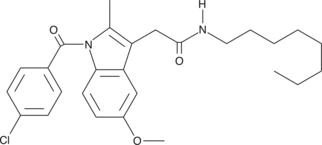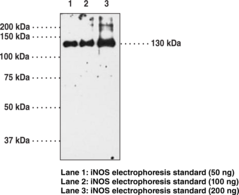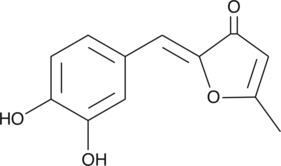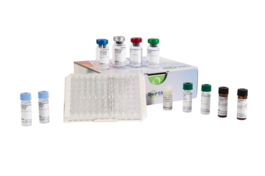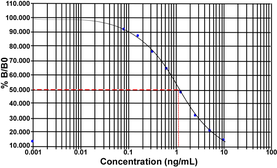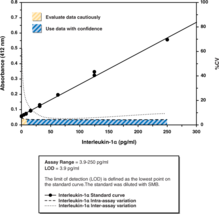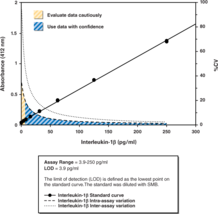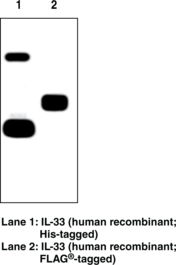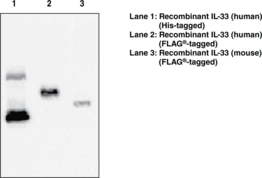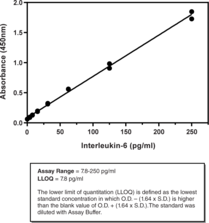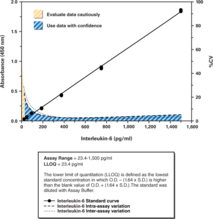Cayman
Showing 24901–25050 of 45550 results
-
Indole-3-carbinol (I3C) is a natural phytochemical produced in crucifers by the action of myrosinase on glucobrassinin.{32180} It has been shown to have anti-cancer effects, at least in part through inhibition of NF-κB and Akt signaling pathways.{32182} I3C may undergo a condensation reaction in vivo, leading to the production of 3,3’-diindolylmethane (Item No. 15927), which alters the expression of oncogenes and tumor suppressor genes.{32181}
Brand:CaymanSKU:11325 - 25 gAvailable on backorder
-
Indole-3-carbinol (I3C) is a natural phytochemical produced in crucifers by the action of myrosinase on glucobrassinin.{32180} It has been shown to have anti-cancer effects, at least in part through inhibition of NF-κB and Akt signaling pathways.{32182} I3C may undergo a condensation reaction in vivo, leading to the production of 3,3’-diindolylmethane (Item No. 15927), which alters the expression of oncogenes and tumor suppressor genes.{32181}
Brand:CaymanSKU:11325 - 5 gAvailable on backorder
-
Indole-3-carboxyaldehyde is an active metabolite of tryptophan and a synthetic intermediate.{53935,53936,53937} It is produced by lactobacilli in the gut microbiota via the indole pyruvate pathway, which is catalyzed by aromatic amino acid aminotransferase (ArAT).{53935} Indole-3-carboxyaldehyde (18 mg/kg) increases colonic production of IL-22 and restores colonization resistance to C. albicans infection in a wild-type, but not aryl hydrocarbon receptor knockout (Ahr-/-), mouse model of mucosal candidiasis. It also reduces intestinal mucosal damage in a mouse model of colitis induced by dextran sulfate (DSS; Item No. 23250). Indole-3-carboxaldehyde has been used as a synthetic intermediate in the synthesis of Schiff bases and ergot alkaloids.{53936,53937}
Brand:CaymanSKU:31328 - 10 gAvailable on backorder
-
Indole-3-carboxyaldehyde is an active metabolite of tryptophan and a synthetic intermediate.{53935,53936,53937} It is produced by lactobacilli in the gut microbiota via the indole pyruvate pathway, which is catalyzed by aromatic amino acid aminotransferase (ArAT).{53935} Indole-3-carboxyaldehyde (18 mg/kg) increases colonic production of IL-22 and restores colonization resistance to C. albicans infection in a wild-type, but not aryl hydrocarbon receptor knockout (Ahr-/-), mouse model of mucosal candidiasis. It also reduces intestinal mucosal damage in a mouse model of colitis induced by dextran sulfate (DSS; Item No. 23250). Indole-3-carboxaldehyde has been used as a synthetic intermediate in the synthesis of Schiff bases and ergot alkaloids.{53936,53937}
Brand:CaymanSKU:31328 - 100 gAvailable on backorder
-
Indole-3-carboxyaldehyde is an active metabolite of tryptophan and a synthetic intermediate.{53935,53936,53937} It is produced by lactobacilli in the gut microbiota via the indole pyruvate pathway, which is catalyzed by aromatic amino acid aminotransferase (ArAT).{53935} Indole-3-carboxyaldehyde (18 mg/kg) increases colonic production of IL-22 and restores colonization resistance to C. albicans infection in a wild-type, but not aryl hydrocarbon receptor knockout (Ahr-/-), mouse model of mucosal candidiasis. It also reduces intestinal mucosal damage in a mouse model of colitis induced by dextran sulfate (DSS; Item No. 23250). Indole-3-carboxaldehyde has been used as a synthetic intermediate in the synthesis of Schiff bases and ergot alkaloids.{53936,53937}
Brand:CaymanSKU:31328 - 25 gAvailable on backorder
-
Indole-3-carboxyaldehyde is an active metabolite of tryptophan and a synthetic intermediate.{53935,53936,53937} It is produced by lactobacilli in the gut microbiota via the indole pyruvate pathway, which is catalyzed by aromatic amino acid aminotransferase (ArAT).{53935} Indole-3-carboxyaldehyde (18 mg/kg) increases colonic production of IL-22 and restores colonization resistance to C. albicans infection in a wild-type, but not aryl hydrocarbon receptor knockout (Ahr-/-), mouse model of mucosal candidiasis. It also reduces intestinal mucosal damage in a mouse model of colitis induced by dextran sulfate (DSS; Item No. 23250). Indole-3-carboxaldehyde has been used as a synthetic intermediate in the synthesis of Schiff bases and ergot alkaloids.{53936,53937}
Brand:CaymanSKU:31328 - 50 gAvailable on backorder
-
Indole-3-carboxylic acid is a plant metabolite derived from tryptophan that has been found in Arabidopsis and has diverse biological activities.{57276,57277,57278,57279} It induces resistance in Arabidopsis against the plant necrotrophic fungus P. cucumerina when applied as a soil-drenching solution at a concentration of 150 µM prior to infection.{57277} Indole-3-carboxylic acid is cytotoxic to A549 human lung and MCF-7 human breast cancer cells (EC50s = 4.6 and 12.9 µg/ml, respectively) and inhibits HIV replication in infected H9 lymphocytes (IC50 = 16.4 µg/ml).{57278} Indole-3-carboxylic acid has also been used as a precursor in the synthesis of substituted thiadiazoles with anticancer activity.{57279}
Brand:CaymanSKU:31166 - 100 gAvailable on backorder
-
Indole-3-carboxylic acid is a plant metabolite derived from tryptophan that has been found in Arabidopsis and has diverse biological activities.{57276,57277,57278,57279} It induces resistance in Arabidopsis against the plant necrotrophic fungus P. cucumerina when applied as a soil-drenching solution at a concentration of 150 µM prior to infection.{57277} Indole-3-carboxylic acid is cytotoxic to A549 human lung and MCF-7 human breast cancer cells (EC50s = 4.6 and 12.9 µg/ml, respectively) and inhibits HIV replication in infected H9 lymphocytes (IC50 = 16.4 µg/ml).{57278} Indole-3-carboxylic acid has also been used as a precursor in the synthesis of substituted thiadiazoles with anticancer activity.{57279}
Brand:CaymanSKU:31166 - 25 gAvailable on backorder
-
Indole-3-carboxylic acid is a plant metabolite derived from tryptophan that has been found in Arabidopsis and has diverse biological activities.{57276,57277,57278,57279} It induces resistance in Arabidopsis against the plant necrotrophic fungus P. cucumerina when applied as a soil-drenching solution at a concentration of 150 µM prior to infection.{57277} Indole-3-carboxylic acid is cytotoxic to A549 human lung and MCF-7 human breast cancer cells (EC50s = 4.6 and 12.9 µg/ml, respectively) and inhibits HIV replication in infected H9 lymphocytes (IC50 = 16.4 µg/ml).{57278} Indole-3-carboxylic acid has also been used as a precursor in the synthesis of substituted thiadiazoles with anticancer activity.{57279}
Brand:CaymanSKU:31166 - 250 gAvailable on backorder
-
Indole-3-carboxylic acid is a plant metabolite derived from tryptophan that has been found in Arabidopsis and has diverse biological activities.{57276,57277,57278,57279} It induces resistance in Arabidopsis against the plant necrotrophic fungus P. cucumerina when applied as a soil-drenching solution at a concentration of 150 µM prior to infection.{57277} Indole-3-carboxylic acid is cytotoxic to A549 human lung and MCF-7 human breast cancer cells (EC50s = 4.6 and 12.9 µg/ml, respectively) and inhibits HIV replication in infected H9 lymphocytes (IC50 = 16.4 µg/ml).{57278} Indole-3-carboxylic acid has also been used as a precursor in the synthesis of substituted thiadiazoles with anticancer activity.{57279}
Brand:CaymanSKU:31166 - 50 gAvailable on backorder
-
Indole-3-propionic acid is a bacterial metabolite that has antioxidant and neuroprotective activities.{53033,53034,53035} It scavenges ABTS (Item No. 27317) radicals in a cell-free assay when used at concentrations ranging from 50 to 150 µM and decreases hydrogen peroxide-induced malondialdehyde (MDA) levels in rat striatal membranes (IC50 = 180 µM).{53034} Indole-3-propionic acid also decreases increases in MDA levels induced by amyloid β (1-42) (Item No. 20574) in PC12 cells.{53036} It decreases ischemia-induced increases in cell death of pyramidal neurons and levels of 4-hydroxy nonenal (HNE; Item No. 32100) and glial fibrillary acidic protein (GFAP) in the hippocampal CA1 region in gerbils when administered at a dose of 10 mg/kg per day.{53035}
Brand:CaymanSKU:28821 - 10 gAvailable on backorder
-
Indole-3-propionic acid is a bacterial metabolite that has antioxidant and neuroprotective activities.{53033,53034,53035} It scavenges ABTS (Item No. 27317) radicals in a cell-free assay when used at concentrations ranging from 50 to 150 µM and decreases hydrogen peroxide-induced malondialdehyde (MDA) levels in rat striatal membranes (IC50 = 180 µM).{53034} Indole-3-propionic acid also decreases increases in MDA levels induced by amyloid β (1-42) (Item No. 20574) in PC12 cells.{53036} It decreases ischemia-induced increases in cell death of pyramidal neurons and levels of 4-hydroxy nonenal (HNE; Item No. 32100) and glial fibrillary acidic protein (GFAP) in the hippocampal CA1 region in gerbils when administered at a dose of 10 mg/kg per day.{53035}
Brand:CaymanSKU:28821 - 100 gAvailable on backorder
-
Indole-3-propionic acid is a bacterial metabolite that has antioxidant and neuroprotective activities.{53033,53034,53035} It scavenges ABTS (Item No. 27317) radicals in a cell-free assay when used at concentrations ranging from 50 to 150 µM and decreases hydrogen peroxide-induced malondialdehyde (MDA) levels in rat striatal membranes (IC50 = 180 µM).{53034} Indole-3-propionic acid also decreases increases in MDA levels induced by amyloid β (1-42) (Item No. 20574) in PC12 cells.{53036} It decreases ischemia-induced increases in cell death of pyramidal neurons and levels of 4-hydroxy nonenal (HNE; Item No. 32100) and glial fibrillary acidic protein (GFAP) in the hippocampal CA1 region in gerbils when administered at a dose of 10 mg/kg per day.{53035}
Brand:CaymanSKU:28821 - 5 gAvailable on backorder
-
Indole-3-propionic acid is a bacterial metabolite that has antioxidant and neuroprotective activities.{53033,53034,53035} It scavenges ABTS (Item No. 27317) radicals in a cell-free assay when used at concentrations ranging from 50 to 150 µM and decreases hydrogen peroxide-induced malondialdehyde (MDA) levels in rat striatal membranes (IC50 = 180 µM).{53034} Indole-3-propionic acid also decreases increases in MDA levels induced by amyloid β (1-42) (Item No. 20574) in PC12 cells.{53036} It decreases ischemia-induced increases in cell death of pyramidal neurons and levels of 4-hydroxy nonenal (HNE; Item No. 32100) and glial fibrillary acidic protein (GFAP) in the hippocampal CA1 region in gerbils when administered at a dose of 10 mg/kg per day.{53035}
Brand:CaymanSKU:28821 - 50 gAvailable on backorder
-
Indole-3-pyruvic acid is an endogenous metabolite of tryptophan and intermediate in the biosynthesis of the major auxin hormone, indole-3-acetic acid (IAA; Item No. 16954), in plants.{52871,52872,52873} Indole-3-pyruvic acid (50 and 250 µM) activates the aryl hydrocarbon receptor (AhR) in a reporter assay.{52871} It reduces UVB-induced cytotoxicity and the levels of COX-2 in HaCaT keratinocytes.{52874} Topical administration of indole-3-pyruvic acid (100 µmol) reduces the severity of UVB-induced damage in mouse skin. Dietary administration of indole-3-pyruvic acid (0.1%) reduces diarrhea, colonic inflammation, and the colonic expression of Il1b, Ifng, Tnfa, and Il12b in a mouse model of T cell-mediated colitis.{52871} It increases the time spent in the open arms of the elevated plus maze in mice when administered at a dose of 100 mg/kg.{52872} It also reverses the anxiogenic effect of caffeine (Item No. 14118) and 3-hydroxy kynurenine, but not pentylenetetrazole (Item No. 18682) or phenylethylamine, in the elevated plus maze in mice.
Brand:CaymanSKU:29876 - 1 gAvailable on backorder
-
Indole-3-pyruvic acid is an endogenous metabolite of tryptophan and intermediate in the biosynthesis of the major auxin hormone, indole-3-acetic acid (IAA; Item No. 16954), in plants.{52871,52872,52873} Indole-3-pyruvic acid (50 and 250 µM) activates the aryl hydrocarbon receptor (AhR) in a reporter assay.{52871} It reduces UVB-induced cytotoxicity and the levels of COX-2 in HaCaT keratinocytes.{52874} Topical administration of indole-3-pyruvic acid (100 µmol) reduces the severity of UVB-induced damage in mouse skin. Dietary administration of indole-3-pyruvic acid (0.1%) reduces diarrhea, colonic inflammation, and the colonic expression of Il1b, Ifng, Tnfa, and Il12b in a mouse model of T cell-mediated colitis.{52871} It increases the time spent in the open arms of the elevated plus maze in mice when administered at a dose of 100 mg/kg.{52872} It also reverses the anxiogenic effect of caffeine (Item No. 14118) and 3-hydroxy kynurenine, but not pentylenetetrazole (Item No. 18682) or phenylethylamine, in the elevated plus maze in mice.
Brand:CaymanSKU:29876 - 250 mgAvailable on backorder
-
Indole-3-pyruvic acid is an endogenous metabolite of tryptophan and intermediate in the biosynthesis of the major auxin hormone, indole-3-acetic acid (IAA; Item No. 16954), in plants.{52871,52872,52873} Indole-3-pyruvic acid (50 and 250 µM) activates the aryl hydrocarbon receptor (AhR) in a reporter assay.{52871} It reduces UVB-induced cytotoxicity and the levels of COX-2 in HaCaT keratinocytes.{52874} Topical administration of indole-3-pyruvic acid (100 µmol) reduces the severity of UVB-induced damage in mouse skin. Dietary administration of indole-3-pyruvic acid (0.1%) reduces diarrhea, colonic inflammation, and the colonic expression of Il1b, Ifng, Tnfa, and Il12b in a mouse model of T cell-mediated colitis.{52871} It increases the time spent in the open arms of the elevated plus maze in mice when administered at a dose of 100 mg/kg.{52872} It also reverses the anxiogenic effect of caffeine (Item No. 14118) and 3-hydroxy kynurenine, but not pentylenetetrazole (Item No. 18682) or phenylethylamine, in the elevated plus maze in mice.
Brand:CaymanSKU:29876 - 500 mgAvailable on backorder
-
Brand:CaymanSKU:11065 - 1 g
Available on backorder
-
Brand:CaymanSKU:11065 - 250 mg
Available on backorder
-
Brand:CaymanSKU:11065 - 500 mg
Available on backorder
-
Indolmycin is an antibiotic isolated from various Streptomyces strains that functions by competitively inhibiting the prokaryotic tryptophanyl-tRNA synthetase (IC50 = 30 μM) without significantly affecting the corresponding eukaryotic synthetase.{24924,24923} It exhibits antibacterial activity against mupirocin- and fusidic acid-resistant strains of Staphylococci.{24922}
Brand:CaymanSKU:- -
Indolmycin is an antibiotic isolated from various Streptomyces strains that functions by competitively inhibiting the prokaryotic tryptophanyl-tRNA synthetase (IC50 = 30 μM) without significantly affecting the corresponding eukaryotic synthetase.{24924,24923} It exhibits antibacterial activity against mupirocin- and fusidic acid-resistant strains of Staphylococci.{24922}
Brand:CaymanSKU:- -
Indomethacin is a non-selective COX inhibitor (IC50s = 1.67 and 24.6 µM for human COX-1 and COX-2, respectively).{1286} It reduces filter paper-disc induced growth of granulation tissue, a marker of inflammation, in chick chorioallantoic membranes.{37630} Indomethacin reduces ocular inflammation induced by bovine serum in rabbits.{37631} It also reduces paw edema in a rat model of carrageenan-induced inflammation.{37632}
Brand:CaymanSKU:70270 - 1 gAvailable on backorder
-
Indomethacin is a potent but non-selective inhibitor of both COX-1 and COX-2 in sheep and humans.{1286} Structurally, indomethacin is a substituted indole acetic acid, wherein the carboxylate can be derivatized as an ester or amide. These derivatives show enhanced selectivity for the COX-2 isoform. For example, the IC50 for indomethacin heptyl ester for the inhibition of human recombinant COX-2 is 0.04 µM, making it more than 1,700 times more potent as an inhibitor of COX-2 than COX-1.{8243} While indomethacin itself has an IC50 of 0.05 µM for the inhibition of COX-2, it also inhibits COX-1 with a corresponding IC50 of 0.67 µM.{8243}
Brand:CaymanSKU:70271 - 1 mgAvailable on backorder
-
Indomethacin is a potent but non-selective inhibitor of both COX-1 and COX-2 in sheep and humans.{1286} Structurally, indomethacin is a substituted indole acetic acid, wherein the carboxylate can be derivatized as an ester or amide. These derivatives show enhanced selectivity for the COX-2 isoform. For example, the IC50 for indomethacin heptyl ester for the inhibition of human recombinant COX-2 is 0.04 µM, making it more than 1,700 times more potent as an inhibitor of COX-2 than COX-1.{8243} While indomethacin itself has an IC50 of 0.05 µM for the inhibition of COX-2, it also inhibits COX-1 with a corresponding IC50 of 0.67 µM.{8243}
Brand:CaymanSKU:70271 - 10 mgAvailable on backorder
-
Indomethacin is a potent but non-selective inhibitor of both COX-1 and COX-2 in sheep and humans.{1286} Structurally, indomethacin is a substituted indole acetic acid, wherein the carboxylate can be derivatized as an ester or amide. These derivatives show enhanced selectivity for the COX-2 isoform. For example, the IC50 for indomethacin heptyl ester for the inhibition of human recombinant COX-2 is 0.04 µM, making it more than 1,700 times more potent as an inhibitor of COX-2 than COX-1.{8243} While indomethacin itself has an IC50 of 0.05 µM for the inhibition of COX-2, it also inhibits COX-1 with a corresponding IC50 of 0.67 µM.{8243}
Brand:CaymanSKU:70271 - 5 mgAvailable on backorder
-
Indomethacin is a potent but non-selective inhibitor of both COX-1 and COX-2 in sheep and humans.{1286} Structurally, indomethacin is a substituted indole acetic acid, wherein the carboxylate can be derivatized as an ester or amide. These derivatives show enhanced selectivity for the COX-2 isoform. For example, the IC50 for indomethacin heptyl ester for the inhibition of human recombinant COX-2 is 0.04 µM, making it more than 1,700 times more potent as an inhibitor of COX-2 than COX-1.{8243} While indomethacin itself has an IC50 of 0.05 µM for the inhibition of COX-2, it also inhibits COX-1 with a corresponding IC50 of 0.67 µM.{8243}
Brand:CaymanSKU:70271 - 50 mgAvailable on backorder
-
Indomethacin is a potent but non-selective inhibitor of both COX-1 and COX-2 in sheep and humans.{1286} Structurally, indomethacin is a substituted indole acetic acid, wherein the carboxylate can be derivitized as an ester or amide. These derivatives show enhanced selectivity for the COX-2 isoform. For example, the IC50 values of indomethacin N-octyl amide for the inhibition of ovine COX-1 and human recombinant COX-2 are 66 µM and 40 nM, respectively, making it 1,650 times more potent as an inhibitor of COX-2 than COX-1.{8243} While indomethacin itself has an IC50 of 0.05 µM for the inhibition of COX-2, it also inhibits COX-1 with a corresponding IC50 of 0.67 µM.
Brand:CaymanSKU:70273 - 1 mgAvailable on backorder
-
Indomethacin is a potent but non-selective inhibitor of both COX-1 and COX-2 in sheep and humans.{1286} Structurally, indomethacin is a substituted indole acetic acid, wherein the carboxylate can be derivitized as an ester or amide. These derivatives show enhanced selectivity for the COX-2 isoform. For example, the IC50 values of indomethacin N-octyl amide for the inhibition of ovine COX-1 and human recombinant COX-2 are 66 µM and 40 nM, respectively, making it 1,650 times more potent as an inhibitor of COX-2 than COX-1.{8243} While indomethacin itself has an IC50 of 0.05 µM for the inhibition of COX-2, it also inhibits COX-1 with a corresponding IC50 of 0.67 µM.
Brand:CaymanSKU:70273 - 10 mgAvailable on backorder
-
Indomethacin is a potent but non-selective inhibitor of both COX-1 and COX-2 in sheep and humans.{1286} Structurally, indomethacin is a substituted indole acetic acid, wherein the carboxylate can be derivitized as an ester or amide. These derivatives show enhanced selectivity for the COX-2 isoform. For example, the IC50 values of indomethacin N-octyl amide for the inhibition of ovine COX-1 and human recombinant COX-2 are 66 µM and 40 nM, respectively, making it 1,650 times more potent as an inhibitor of COX-2 than COX-1.{8243} While indomethacin itself has an IC50 of 0.05 µM for the inhibition of COX-2, it also inhibits COX-1 with a corresponding IC50 of 0.67 µM.
Brand:CaymanSKU:70273 - 5 mgAvailable on backorder
-
Indomethacin is a potent but non-selective inhibitor of both COX-1 and COX-2 in sheep and humans.{1286} Structurally, indomethacin is a substituted indole acetic acid, wherein the carboxylate can be derivitized as an ester or amide. These derivatives show enhanced selectivity for the COX-2 isoform. For example, the IC50 values of indomethacin N-octyl amide for the inhibition of ovine COX-1 and human recombinant COX-2 are 66 µM and 40 nM, respectively, making it 1,650 times more potent as an inhibitor of COX-2 than COX-1.{8243} While indomethacin itself has an IC50 of 0.05 µM for the inhibition of COX-2, it also inhibits COX-1 with a corresponding IC50 of 0.67 µM.
Brand:CaymanSKU:70273 - 50 mgAvailable on backorder
-
Indomethacin-d4 is intended for use as an internal standard for the quantification of indomethacin (Item No. 70270) by GC- or LC-MS. Indomethacin is a non-selective COX inhibitor (IC50s = 1.67 and 24.6 µM for human COX-1 and COX-2, respectively).{1286} It reduces filter paper-disc induced growth of granulation tissue, a marker of inflammation, in chick chorioallantoic membranes.{37630} Indomethacin reduces ocular inflammation induced by bovine serum in rabbits.{37631} It also reduces paw edema in a rat model of carrageenan-induced inflammation.{37632}
Brand:CaymanSKU:25434 - 1 mgAvailable on backorder
-
Indomethacin-d4 is intended for use as an internal standard for the quantification of indomethacin (Item No. 70270) by GC- or LC-MS. Indomethacin is a non-selective COX inhibitor (IC50s = 1.67 and 24.6 µM for human COX-1 and COX-2, respectively).{1286} It reduces filter paper-disc induced growth of granulation tissue, a marker of inflammation, in chick chorioallantoic membranes.{37630} Indomethacin reduces ocular inflammation induced by bovine serum in rabbits.{37631} It also reduces paw edema in a rat model of carrageenan-induced inflammation.{37632}
Brand:CaymanSKU:25434 - 500 µgAvailable on backorder
-
Indoxyl sulfate is a metabolite of tryptophan derived from dietary protein. Tryptophan is metabolized by intestinal bacteria into indole, which is absorbed into the blood and then further metabolized to indoxyl sulfate in the liver, which is normally excreted in urine. In chronic kidney disease patients where renal function is compromised, indoxyl sulfate can accumulate in serum as a uremic toxin, inducing oxidative stress and accelerating progression of the disease.{27740} Indoxyl sulfate at 250 µM can induce the activation of NF-κB, promoting the expression of both TGF-β1 and Smad3 expression in proximal tubular cells of rats, which is associated with profibrotic activity.{26427}
Brand:CaymanSKU:-Out of stock
-
Indoxyl sulfate is a metabolite of tryptophan derived from dietary protein. Tryptophan is metabolized by intestinal bacteria into indole, which is absorbed into the blood and then further metabolized to indoxyl sulfate in the liver, which is normally excreted in urine. In chronic kidney disease patients where renal function is compromised, indoxyl sulfate can accumulate in serum as a uremic toxin, inducing oxidative stress and accelerating progression of the disease.{27740} Indoxyl sulfate at 250 µM can induce the activation of NF-κB, promoting the expression of both TGF-β1 and Smad3 expression in proximal tubular cells of rats, which is associated with profibrotic activity.{26427}
Brand:CaymanSKU:-Out of stock
-
Indoxyl sulfate is a metabolite of tryptophan derived from dietary protein. Tryptophan is metabolized by intestinal bacteria into indole, which is absorbed into the blood and then further metabolized to indoxyl sulfate in the liver, which is normally excreted in urine. In chronic kidney disease patients where renal function is compromised, indoxyl sulfate can accumulate in serum as a uremic toxin, inducing oxidative stress and accelerating progression of the disease.{27740} Indoxyl sulfate at 250 µM can induce the activation of NF-κB, promoting the expression of both TGF-β1 and Smad3 expression in proximal tubular cells of rats, which is associated with profibrotic activity.{26427}
Brand:CaymanSKU:-Out of stock
-
Indoxyl sulfate is a metabolite of tryptophan derived from dietary protein. Tryptophan is metabolized by intestinal bacteria into indole, which is absorbed into the blood and then further metabolized to indoxyl sulfate in the liver, which is normally excreted in urine. In chronic kidney disease patients where renal function is compromised, indoxyl sulfate can accumulate in serum as a uremic toxin, inducing oxidative stress and accelerating progression of the disease.{27740} Indoxyl sulfate at 250 µM can induce the activation of NF-κB, promoting the expression of both TGF-β1 and Smad3 expression in proximal tubular cells of rats, which is associated with profibrotic activity.{26427}
Brand:CaymanSKU:-Out of stock
-
INDY is an ATP-competitive inhibitor of dual-specificity tyrosine-(Y)-phosphorylation regulated kinase 1A (DYRK1A; Ki = 180 nM; IC50 = 240 nM).{38762} It is selective for DYRK1A over monoamine oxidase (MAO) A and B at concentrations up to 100 μM. INDY inhibits DYRK1A phosphorylation of tau in COS-7 cells expressing EGFP-DYRK1A and EGFP-tau in a concentration-dependent manner. It also restores signaling through nuclear factory of activated T cells (NFAT) and NFAT-dependent transcription in HEK293 cells overexpressing DYRK1A. In vivo, INDY reverses developmental deformities induced by DYRK1A overexpression in X. laevis embryos. INDY also induces proliferation of human and rat β-cells and increases insulin secretion by human islets in vitro.{38763}
Brand:CaymanSKU:23895 - 1 mgAvailable on backorder
-
INDY is an ATP-competitive inhibitor of dual-specificity tyrosine-(Y)-phosphorylation regulated kinase 1A (DYRK1A; Ki = 180 nM; IC50 = 240 nM).{38762} It is selective for DYRK1A over monoamine oxidase (MAO) A and B at concentrations up to 100 μM. INDY inhibits DYRK1A phosphorylation of tau in COS-7 cells expressing EGFP-DYRK1A and EGFP-tau in a concentration-dependent manner. It also restores signaling through nuclear factory of activated T cells (NFAT) and NFAT-dependent transcription in HEK293 cells overexpressing DYRK1A. In vivo, INDY reverses developmental deformities induced by DYRK1A overexpression in X. laevis embryos. INDY also induces proliferation of human and rat β-cells and increases insulin secretion by human islets in vitro.{38763}
Brand:CaymanSKU:23895 - 10 mgAvailable on backorder
-
INDY is an ATP-competitive inhibitor of dual-specificity tyrosine-(Y)-phosphorylation regulated kinase 1A (DYRK1A; Ki = 180 nM; IC50 = 240 nM).{38762} It is selective for DYRK1A over monoamine oxidase (MAO) A and B at concentrations up to 100 μM. INDY inhibits DYRK1A phosphorylation of tau in COS-7 cells expressing EGFP-DYRK1A and EGFP-tau in a concentration-dependent manner. It also restores signaling through nuclear factory of activated T cells (NFAT) and NFAT-dependent transcription in HEK293 cells overexpressing DYRK1A. In vivo, INDY reverses developmental deformities induced by DYRK1A overexpression in X. laevis embryos. INDY also induces proliferation of human and rat β-cells and increases insulin secretion by human islets in vitro.{38763}
Brand:CaymanSKU:23895 - 25 mgAvailable on backorder
-
INDY is an ATP-competitive inhibitor of dual-specificity tyrosine-(Y)-phosphorylation regulated kinase 1A (DYRK1A; Ki = 180 nM; IC50 = 240 nM).{38762} It is selective for DYRK1A over monoamine oxidase (MAO) A and B at concentrations up to 100 μM. INDY inhibits DYRK1A phosphorylation of tau in COS-7 cells expressing EGFP-DYRK1A and EGFP-tau in a concentration-dependent manner. It also restores signaling through nuclear factory of activated T cells (NFAT) and NFAT-dependent transcription in HEK293 cells overexpressing DYRK1A. In vivo, INDY reverses developmental deformities induced by DYRK1A overexpression in X. laevis embryos. INDY also induces proliferation of human and rat β-cells and increases insulin secretion by human islets in vitro.{38763}
Brand:CaymanSKU:23895 - 5 mgAvailable on backorder
-
INF39 is an irreversible inhibitor of the NLRP3 inflammasome.{46402} INF39 (10 µM) inhibits activation of caspase-1 and the release of IL-1β and lactate dehydrogenase (LDH) induced by ATP (Item No. 14498) or nigericin (Item No. 11437) in LPS-primed bone marrow-derived macrophages (BMDMs). It reduces ATP-induced pyroptosis in LPS-primed THP-1 cells by 33.6% when used at a concentration of 10 µM. INF39 (12.5, 25, and 50 mg/kg) prevents increases in IL-1β protein levels induced by dinitrobenzene sulfonic acid (DNBS) in the colon in a rat model of colitis. It reduces the severity of pancreatic lesions and serum levels of IL-1β, TNF-α, and IL-6 during caerulein- and LPS-induced pancreatitis in mice when administered at doses of 25 and 50 mg/kg.{46403}
Brand:CaymanSKU:28476 - 10 mgAvailable on backorder
-
INF39 is an irreversible inhibitor of the NLRP3 inflammasome.{46402} INF39 (10 µM) inhibits activation of caspase-1 and the release of IL-1β and lactate dehydrogenase (LDH) induced by ATP (Item No. 14498) or nigericin (Item No. 11437) in LPS-primed bone marrow-derived macrophages (BMDMs). It reduces ATP-induced pyroptosis in LPS-primed THP-1 cells by 33.6% when used at a concentration of 10 µM. INF39 (12.5, 25, and 50 mg/kg) prevents increases in IL-1β protein levels induced by dinitrobenzene sulfonic acid (DNBS) in the colon in a rat model of colitis. It reduces the severity of pancreatic lesions and serum levels of IL-1β, TNF-α, and IL-6 during caerulein- and LPS-induced pancreatitis in mice when administered at doses of 25 and 50 mg/kg.{46403}
Brand:CaymanSKU:28476 - 25 mgAvailable on backorder
-
INF39 is an irreversible inhibitor of the NLRP3 inflammasome.{46402} INF39 (10 µM) inhibits activation of caspase-1 and the release of IL-1β and lactate dehydrogenase (LDH) induced by ATP (Item No. 14498) or nigericin (Item No. 11437) in LPS-primed bone marrow-derived macrophages (BMDMs). It reduces ATP-induced pyroptosis in LPS-primed THP-1 cells by 33.6% when used at a concentration of 10 µM. INF39 (12.5, 25, and 50 mg/kg) prevents increases in IL-1β protein levels induced by dinitrobenzene sulfonic acid (DNBS) in the colon in a rat model of colitis. It reduces the severity of pancreatic lesions and serum levels of IL-1β, TNF-α, and IL-6 during caerulein- and LPS-induced pancreatitis in mice when administered at doses of 25 and 50 mg/kg.{46403}
Brand:CaymanSKU:28476 - 5 mgAvailable on backorder
-
Inflachromene is an anti-inflammatory agent that directly binds high mobility group protein 1 (HMGB1) and HMGB2 and reduces their cytoplasmic accumulation in microglial cells.{27536} It is functional in vivo, downregulating proinflammatory functions of HMGB proteins and reducing neuronal damage.{27536} Inflachromene also ameliorates inflammatory pathogenesis in a mouse model of sepsis.{33796}
Brand:CaymanSKU:-Out of stock
-
Inflachromene is an anti-inflammatory agent that directly binds high mobility group protein 1 (HMGB1) and HMGB2 and reduces their cytoplasmic accumulation in microglial cells.{27536} It is functional in vivo, downregulating proinflammatory functions of HMGB proteins and reducing neuronal damage.{27536} Inflachromene also ameliorates inflammatory pathogenesis in a mouse model of sepsis.{33796}
Brand:CaymanSKU:-Out of stock
-
Inflachromene is an anti-inflammatory agent that directly binds high mobility group protein 1 (HMGB1) and HMGB2 and reduces their cytoplasmic accumulation in microglial cells.{27536} It is functional in vivo, downregulating proinflammatory functions of HMGB proteins and reducing neuronal damage.{27536} Inflachromene also ameliorates inflammatory pathogenesis in a mouse model of sepsis.{33796}
Brand:CaymanSKU:-Out of stock
-
Ingenol is a diterpenoid related to phorbol, derived from the milkweed plant E. peplus.{771} It is a protein kinase C activator that displays a Ki value of 30 μM and an ED50 value of 27 μM in vitro.{23438,23437} Most ingenol esters are tumor-promoting.{17808} However, ingenol mebutate possesses anti-tumor activity when used topically for actinic keratosis.{21836}
Brand:CaymanSKU:- -
Ingenol is a diterpenoid related to phorbol, derived from the milkweed plant E. peplus.{771} It is a protein kinase C activator that displays a Ki value of 30 μM and an ED50 value of 27 μM in vitro.{23438,23437} Most ingenol esters are tumor-promoting.{17808} However, ingenol mebutate possesses anti-tumor activity when used topically for actinic keratosis.{21836}
Brand:CaymanSKU:- -
Ingenol is a diterpenoid related to phorbol, derived from the milkweed plant E. peplus.{771} It is a protein kinase C activator that displays a Ki value of 30 μM and an ED50 value of 27 μM in vitro.{23438,23437} Most ingenol esters are tumor-promoting.{17808} However, ingenol mebutate possesses anti-tumor activity when used topically for actinic keratosis.{21836}
Brand:CaymanSKU:- -
Ingenol is a diterpenoid related to phorbol, derived from the milkweed plant E. peplus.{771} It is a protein kinase C activator that displays a Ki value of 30 μM and an ED50 value of 27 μM in vitro.{23438,23437} Most ingenol esters are tumor-promoting.{17808} However, ingenol mebutate possesses anti-tumor activity when used topically for actinic keratosis.{21836}
Brand:CaymanSKU:- -
Ingenol-3-angelate is a hydrophobic diterpene ester that can be isolated from the euphorb E. peplus. It rapidly induces cell death in proliferating keratinocytes through plasma membrane and mitochondrial disruption, although it can also initiate apoptosis in some cancer cell lines (LD90 = ~190 µM).{26474} Secondarily, ingenol-3-angelate causes inflammation due, at least in part, to activation of PKC, leading to antibody-dependent cellular cytotoxicity.{26475,26472,23438} These actions have relevance in diminishing actinic keratosis and, possibly, other cancers of the skin.{21836,26473}
Brand:CaymanSKU:- -
Ingenol-3-angelate is a hydrophobic diterpene ester that can be isolated from the euphorb E. peplus. It rapidly induces cell death in proliferating keratinocytes through plasma membrane and mitochondrial disruption, although it can also initiate apoptosis in some cancer cell lines (LD90 = ~190 µM).{26474} Secondarily, ingenol-3-angelate causes inflammation due, at least in part, to activation of PKC, leading to antibody-dependent cellular cytotoxicity.{26475,26472,23438} These actions have relevance in diminishing actinic keratosis and, possibly, other cancers of the skin.{21836,26473}
Brand:CaymanSKU:- -
Ingenol-3-angelate is a hydrophobic diterpene ester that can be isolated from the euphorb E. peplus. It rapidly induces cell death in proliferating keratinocytes through plasma membrane and mitochondrial disruption, although it can also initiate apoptosis in some cancer cell lines (LD90 = ~190 µM).{26474} Secondarily, ingenol-3-angelate causes inflammation due, at least in part, to activation of PKC, leading to antibody-dependent cellular cytotoxicity.{26475,26472,23438} These actions have relevance in diminishing actinic keratosis and, possibly, other cancers of the skin.{21836,26473}
Brand:CaymanSKU:- -
Ingenol-3-angelate is a hydrophobic diterpene ester that can be isolated from the euphorb E. peplus. It rapidly induces cell death in proliferating keratinocytes through plasma membrane and mitochondrial disruption, although it can also initiate apoptosis in some cancer cell lines (LD90 = ~190 µM).{26474} Secondarily, ingenol-3-angelate causes inflammation due, at least in part, to activation of PKC, leading to antibody-dependent cellular cytotoxicity.{26475,26472,23438} These actions have relevance in diminishing actinic keratosis and, possibly, other cancers of the skin.{21836,26473}
Brand:CaymanSKU:- -
INH1 is an inhibitor of the interaction between the oncogene high expression in cancer 1 (Hec1) and its regulator, the serine/threonine kinase Nek2.{48794} It binds to Hec1 and reduces Nek2 protein levels in HeLa cells when used at a concentration of 25 µM. INH1 inhibits the growth of MDA-MB-468, SK-BR-3, T47D, MDA-MB-361, ZR-75-1, HBL-100, MDA-MB-435, and Hs 578T breast cancer cells (GI50s = 10.5-20.5 µM). It inhibits migration of MDA-MB-231 cells in a transwell migration assay (IC50 = 176 nM).{48795} INH1 (50 and 100 mg/kg) reduces tumor growth in an MDA-MB-468 mouse xenograft model.{48794}
Brand:CaymanSKU:29015 - 10 mgAvailable on backorder
-
INH1 is an inhibitor of the interaction between the oncogene high expression in cancer 1 (Hec1) and its regulator, the serine/threonine kinase Nek2.{48794} It binds to Hec1 and reduces Nek2 protein levels in HeLa cells when used at a concentration of 25 µM. INH1 inhibits the growth of MDA-MB-468, SK-BR-3, T47D, MDA-MB-361, ZR-75-1, HBL-100, MDA-MB-435, and Hs 578T breast cancer cells (GI50s = 10.5-20.5 µM). It inhibits migration of MDA-MB-231 cells in a transwell migration assay (IC50 = 176 nM).{48795} INH1 (50 and 100 mg/kg) reduces tumor growth in an MDA-MB-468 mouse xenograft model.{48794}
Brand:CaymanSKU:29015 - 25 mgAvailable on backorder
-
INH1 is an inhibitor of the interaction between the oncogene high expression in cancer 1 (Hec1) and its regulator, the serine/threonine kinase Nek2.{48794} It binds to Hec1 and reduces Nek2 protein levels in HeLa cells when used at a concentration of 25 µM. INH1 inhibits the growth of MDA-MB-468, SK-BR-3, T47D, MDA-MB-361, ZR-75-1, HBL-100, MDA-MB-435, and Hs 578T breast cancer cells (GI50s = 10.5-20.5 µM). It inhibits migration of MDA-MB-231 cells in a transwell migration assay (IC50 = 176 nM).{48795} INH1 (50 and 100 mg/kg) reduces tumor growth in an MDA-MB-468 mouse xenograft model.{48794}
Brand:CaymanSKU:29015 - 5 mgAvailable on backorder
-
INH1 is an inhibitor of the interaction between the oncogene high expression in cancer 1 (Hec1) and its regulator, the serine/threonine kinase Nek2.{48794} It binds to Hec1 and reduces Nek2 protein levels in HeLa cells when used at a concentration of 25 µM. INH1 inhibits the growth of MDA-MB-468, SK-BR-3, T47D, MDA-MB-361, ZR-75-1, HBL-100, MDA-MB-435, and Hs 578T breast cancer cells (GI50s = 10.5-20.5 µM). It inhibits migration of MDA-MB-231 cells in a transwell migration assay (IC50 = 176 nM).{48795} INH1 (50 and 100 mg/kg) reduces tumor growth in an MDA-MB-468 mouse xenograft model.{48794}
Brand:CaymanSKU:29015 - 50 mgAvailable on backorder
-
INH6 is an inhibitor of the oncogene high expression in cancer 1 (Hec1) and its regulator, the serine-threonine kinase Nek2, which together regulate mitotic spindle formation.{38094,38095} It inhibits proliferation in human breast, cervical, and leukemia cell lines with IC50 values of 1.7 and 2.1, 2.4, and 2.5 µM, respectively, for MDA-MB-231 and MDA-MB-468, HeLa, and K562 cells.{38094} INH6 co-precipitates with cellular Hec1, reduces Nek2 protein levels when administered to HeLa cells at 6.25 µM, disrupts spindle formation, and induces apoptosis.
Brand:CaymanSKU:21772 -Out of stock
-
INH6 is an inhibitor of the oncogene high expression in cancer 1 (Hec1) and its regulator, the serine-threonine kinase Nek2, which together regulate mitotic spindle formation.{38094,38095} It inhibits proliferation in human breast, cervical, and leukemia cell lines with IC50 values of 1.7 and 2.1, 2.4, and 2.5 µM, respectively, for MDA-MB-231 and MDA-MB-468, HeLa, and K562 cells.{38094} INH6 co-precipitates with cellular Hec1, reduces Nek2 protein levels when administered to HeLa cells at 6.25 µM, disrupts spindle formation, and induces apoptosis.
Brand:CaymanSKU:21772 -Out of stock
-
INH6 is an inhibitor of the oncogene high expression in cancer 1 (Hec1) and its regulator, the serine-threonine kinase Nek2, which together regulate mitotic spindle formation.{38094,38095} It inhibits proliferation in human breast, cervical, and leukemia cell lines with IC50 values of 1.7 and 2.1, 2.4, and 2.5 µM, respectively, for MDA-MB-231 and MDA-MB-468, HeLa, and K562 cells.{38094} INH6 co-precipitates with cellular Hec1, reduces Nek2 protein levels when administered to HeLa cells at 6.25 µM, disrupts spindle formation, and induces apoptosis.
Brand:CaymanSKU:21772 -Out of stock
-
INH6 is an inhibitor of the oncogene high expression in cancer 1 (Hec1) and its regulator, the serine-threonine kinase Nek2, which together regulate mitotic spindle formation.{38094,38095} It inhibits proliferation in human breast, cervical, and leukemia cell lines with IC50 values of 1.7 and 2.1, 2.4, and 2.5 µM, respectively, for MDA-MB-231 and MDA-MB-468, HeLa, and K562 cells.{38094} INH6 co-precipitates with cellular Hec1, reduces Nek2 protein levels when administered to HeLa cells at 6.25 µM, disrupts spindle formation, and induces apoptosis.
Brand:CaymanSKU:21772 -Out of stock
-
INK1117 is an inhibitor of phosphoinositide 3-kinase α (PI3Kα) that is selective for p110α in vitro (IC50 = 15 nM for PI3Kα vs. >1 µM for other isoforms, as well as for mTOR) and in cells when used at 1 µM.{31648,31649} It blocks signaling to Akt and inhibits growth of cancer cells harboring wild-type or mutated p110α.{31648} INK1117 does not interfere with B cell proliferation or NK cell maturation and survival.{31648,31649}
Brand:CaymanSKU:-Available on backorder
-
INK1117 is an inhibitor of phosphoinositide 3-kinase α (PI3Kα) that is selective for p110α in vitro (IC50 = 15 nM for PI3Kα vs. >1 µM for other isoforms, as well as for mTOR) and in cells when used at 1 µM.{31648,31649} It blocks signaling to Akt and inhibits growth of cancer cells harboring wild-type or mutated p110α.{31648} INK1117 does not interfere with B cell proliferation or NK cell maturation and survival.{31648,31649}
Brand:CaymanSKU:-Available on backorder
-
INK1117 is an inhibitor of phosphoinositide 3-kinase α (PI3Kα) that is selective for p110α in vitro (IC50 = 15 nM for PI3Kα vs. >1 µM for other isoforms, as well as for mTOR) and in cells when used at 1 µM.{31648,31649} It blocks signaling to Akt and inhibits growth of cancer cells harboring wild-type or mutated p110α.{31648} INK1117 does not interfere with B cell proliferation or NK cell maturation and survival.{31648,31649}
Brand:CaymanSKU:-Available on backorder
-
INK1117 is an inhibitor of phosphoinositide 3-kinase α (PI3Kα) that is selective for p110α in vitro (IC50 = 15 nM for PI3Kα vs. >1 µM for other isoforms, as well as for mTOR) and in cells when used at 1 µM.{31648,31649} It blocks signaling to Akt and inhibits growth of cancer cells harboring wild-type or mutated p110α.{31648} INK1117 does not interfere with B cell proliferation or NK cell maturation and survival.{31648,31649}
Brand:CaymanSKU:-Available on backorder
-
INK128 is an inhibitor of TORC1/2, acting as an ATP-dependent inhibitor of mTOR kinase (IC50 = 1 nM).{31895,21344,21346} It blocks the phosphorylation of downstream substrates of both TORC1 and TORC2.{21344} INK128 interferes with the growth of cell lines which are resistant to rapamycin and pan-PI3K inhibitors.{21344,21345} Moreover, daily, oral administration of INK128 inhibits angiogenesis and tumor growth in several xenograft models.{21344} The effects of INK128 on gene expression also reduce invasion and metastasis.{20985}
Brand:CaymanSKU:11811 - 1 mgAvailable on backorder
-
INK128 is an inhibitor of TORC1/2, acting as an ATP-dependent inhibitor of mTOR kinase (IC50 = 1 nM).{31895,21344,21346} It blocks the phosphorylation of downstream substrates of both TORC1 and TORC2.{21344} INK128 interferes with the growth of cell lines which are resistant to rapamycin and pan-PI3K inhibitors.{21344,21345} Moreover, daily, oral administration of INK128 inhibits angiogenesis and tumor growth in several xenograft models.{21344} The effects of INK128 on gene expression also reduce invasion and metastasis.{20985}
Brand:CaymanSKU:11811 - 10 mgAvailable on backorder
-
INK128 is an inhibitor of TORC1/2, acting as an ATP-dependent inhibitor of mTOR kinase (IC50 = 1 nM).{31895,21344,21346} It blocks the phosphorylation of downstream substrates of both TORC1 and TORC2.{21344} INK128 interferes with the growth of cell lines which are resistant to rapamycin and pan-PI3K inhibitors.{21344,21345} Moreover, daily, oral administration of INK128 inhibits angiogenesis and tumor growth in several xenograft models.{21344} The effects of INK128 on gene expression also reduce invasion and metastasis.{20985}
Brand:CaymanSKU:11811 - 5 mgAvailable on backorder
-
INK128 is an inhibitor of TORC1/2, acting as an ATP-dependent inhibitor of mTOR kinase (IC50 = 1 nM).{31895,21344,21346} It blocks the phosphorylation of downstream substrates of both TORC1 and TORC2.{21344} INK128 interferes with the growth of cell lines which are resistant to rapamycin and pan-PI3K inhibitors.{21344,21345} Moreover, daily, oral administration of INK128 inhibits angiogenesis and tumor growth in several xenograft models.{21344} The effects of INK128 on gene expression also reduce invasion and metastasis.{20985}
Brand:CaymanSKU:11811 - 50 mgAvailable on backorder
-
Immunogen: purified enzyme from mouse macrophages (RAW 264.7 cells) • Host: Rabbit • Cross Reactivity: (+) iNOS from most mammalian species and nNOS (5%); (−) eNOS • Application(s): IHC, IP, and WB
Brand:CaymanSKU:160862- 1 ea -
Nitric Oxide Synthase (NOS) catalyzes the biosynthesis of nitric oxide from L-arginine. Constitutively expressed NOS is found in brain (nNOS) and endothelial cells (eNOS). iNOS is a soluble enzyme found in a variety of tissues including macrophages, hepatocytes, vascular smooth muscle cells, and chondrocytes.{1243,4141} iNOS expression is increased by a variety of factors including LPS, IFN-γ, Il-1β, and TNF-α, whereas expression is deceased by dexamethasone.{1904,1970,2111,3440,4851} The enzyme has been cloned from several species including mouse, rat, and human with homology of at least 80% between these species.{4141} The calculated molecular weight of the protein from the deduced amino acid sequence is 130,000 – 131,000.{1243}
Brand:CaymanSKU:160862 - 1 eaAvailable on backorder
-
Immunogen: purified enzyme from mouse macrophages (RAW 264.7 cells) • Host: Rabbit • Cross Reactivity: (+) iNOS from most mammalian species and nNOS (5%); (−) eNOS • Application(s): IHC, IP, and WB
Brand:CaymanSKU:160862- 1 eaAvailable on backorder
-
Inosine 5′-triphosphate (ITP) is a nucleoside triphosphate that functions as an alternative substrate for ATPases and GTPases.{47084,47085} It has been used to study activation and binding kinetics of nucleoside interaction with various ATPases and GTPases.
Brand:CaymanSKU:23063 - 100 mgAvailable on backorder
-
Inosine 5′-triphosphate (ITP) is a nucleoside triphosphate that functions as an alternative substrate for ATPases and GTPases.{47084,47085} It has been used to study activation and binding kinetics of nucleoside interaction with various ATPases and GTPases.
Brand:CaymanSKU:23063 - 250 mgAvailable on backorder
-
Inosine 5′-triphosphate (ITP) is a nucleoside triphosphate that functions as an alternative substrate for ATPases and GTPases.{47084,47085} It has been used to study activation and binding kinetics of nucleoside interaction with various ATPases and GTPases.
Brand:CaymanSKU:23063 - 50 mgAvailable on backorder
-
Inosine 5′-triphosphate (ITP) is a nucleoside triphosphate that functions as an alternative substrate for ATPases and GTPases.{47084,47085} It has been used to study activation and binding kinetics of nucleoside interaction with various ATPases and GTPases.
Brand:CaymanSKU:23063 - 500 mgAvailable on backorder
-
Inosine-5′-monophosphate (IMP) is a substrate of IMP dehydrogenase (IMPDH), a NAD+-dependent enzyme that generates xanthosine monophosphate. This is a rate-limiting step in the generation of guanosine monophosphate, which is important for DNA, RNA, and glycoprotein synthesis. Inhibitors of IMPDH, including ribavirin (Item No. 16757) and mycophenolate mofetil (Item No. 13988), have potential applications as antiviral and anti-cancer drugs.{21841,29390,29388} 5-Ribonucleosides, including IMP, are also involved in potentiating the umami taste sensation.{29389}
Brand:CaymanSKU:-Available on backorder
-
Inosine-5′-monophosphate (IMP) is a substrate of IMP dehydrogenase (IMPDH), a NAD+-dependent enzyme that generates xanthosine monophosphate. This is a rate-limiting step in the generation of guanosine monophosphate, which is important for DNA, RNA, and glycoprotein synthesis. Inhibitors of IMPDH, including ribavirin (Item No. 16757) and mycophenolate mofetil (Item No. 13988), have potential applications as antiviral and anti-cancer drugs.{21841,29390,29388} 5-Ribonucleosides, including IMP, are also involved in potentiating the umami taste sensation.{29389}
Brand:CaymanSKU:-Available on backorder
-
Inosine-5′-monophosphate (IMP) is a substrate of IMP dehydrogenase (IMPDH), a NAD+-dependent enzyme that generates xanthosine monophosphate. This is a rate-limiting step in the generation of guanosine monophosphate, which is important for DNA, RNA, and glycoprotein synthesis. Inhibitors of IMPDH, including ribavirin (Item No. 16757) and mycophenolate mofetil (Item No. 13988), have potential applications as antiviral and anti-cancer drugs.{21841,29390,29388} 5-Ribonucleosides, including IMP, are also involved in potentiating the umami taste sensation.{29389}
Brand:CaymanSKU:-Available on backorder
-
Inosine-5′-monophosphate (IMP) is a substrate of IMP dehydrogenase (IMPDH), a NAD+-dependent enzyme that generates xanthosine monophosphate. This is a rate-limiting step in the generation of guanosine monophosphate, which is important for DNA, RNA, and glycoprotein synthesis. Inhibitors of IMPDH, including ribavirin (Item No. 16757) and mycophenolate mofetil (Item No. 13988), have potential applications as antiviral and anti-cancer drugs.{21841,29390,29388} 5-Ribonucleosides, including IMP, are also involved in potentiating the umami taste sensation.{29389}
Brand:CaymanSKU:-Available on backorder
-
Inotilone is a cyclooxygenase (COX) inhibitor found in mushrooms of Phellinus and Inonotus sps. that inhibits COX-2 over COX-1 with IC50 values of 0.03 and 0.36 µM, respectively.{14795,14796} It is a poor inhibitor of hydroxysteroid dehydrogenase and xanthine oxidase (IC50s = 50.4 and 9.1 µM, respectively).{14795,14796} Inotilone demonstrates anti-inflammatory, antiviral, and antioxidant effects in various experimental models.{32528,32529,32530}
Brand:CaymanSKU:10010089 - 1 mgAvailable on backorder
-
Inotilone is a cyclooxygenase (COX) inhibitor found in mushrooms of Phellinus and Inonotus sps. that inhibits COX-2 over COX-1 with IC50 values of 0.03 and 0.36 µM, respectively.{14795,14796} It is a poor inhibitor of hydroxysteroid dehydrogenase and xanthine oxidase (IC50s = 50.4 and 9.1 µM, respectively).{14795,14796} Inotilone demonstrates anti-inflammatory, antiviral, and antioxidant effects in various experimental models.{32528,32529,32530}
Brand:CaymanSKU:10010089 - 10 mgAvailable on backorder
-
Inotilone is a cyclooxygenase (COX) inhibitor found in mushrooms of Phellinus and Inonotus sps. that inhibits COX-2 over COX-1 with IC50 values of 0.03 and 0.36 µM, respectively.{14795,14796} It is a poor inhibitor of hydroxysteroid dehydrogenase and xanthine oxidase (IC50s = 50.4 and 9.1 µM, respectively).{14795,14796} Inotilone demonstrates anti-inflammatory, antiviral, and antioxidant effects in various experimental models.{32528,32529,32530}
Brand:CaymanSKU:10010089 - 25 mgAvailable on backorder
-
Inotilone is a cyclooxygenase (COX) inhibitor found in mushrooms of Phellinus and Inonotus sps. that inhibits COX-2 over COX-1 with IC50 values of 0.03 and 0.36 µM, respectively.{14795,14796} It is a poor inhibitor of hydroxysteroid dehydrogenase and xanthine oxidase (IC50s = 50.4 and 9.1 µM, respectively).{14795,14796} Inotilone demonstrates anti-inflammatory, antiviral, and antioxidant effects in various experimental models.{32528,32529,32530}
Brand:CaymanSKU:10010089 - 5 mgAvailable on backorder
-
This immunoassay is based on a sandwich technique. Wells of supplied plate are coated with a monoclonal antibody specific to insulin. Insulin is introduced in the wells where it is bound by the monoclonal antibody coated on the plate. Insulin is then detected by an insulin-specific monoclonal antibody tagged with acetylcholinesterase (AChE). The two antibodies thus form a sandwich by binding on different epitopes of insulin. The concentration of insulin is determined by measuring the enzymatic activity of immobilized tracer using Ellman’s reagent. AchE tracer acts on Ellman’s reagent to form a yellow compound that strongly absorbs at 405 nm or at 414 nm . Insulin in a polypeptide composed of 51 amino acids divided into two chains (A and B) linked by disulfide bonds. Both chains are organized as alpha helix. Insulin is produced by the beta cells of the pancreatic islets in form of a precursor (prepro-insulin) and is modified to obtain the pro-insulin (peptide signal elimination) and finally insulin (peptide C elimination). The main function of the insulin is the regulation of the glucose concentration in the organism. The dysregulation of the production of insulin induced many disorders including diabetes. [Bertin Bioreagent Product Number [A05322]]
Brand:CaymanSKU:26619 - 96 wellsAvailable on backorder
-
Insulin is a polypeptide hormone with molecular weight of 6,000 Daltons, composed of two peptides chains, A and B, jointed by two cross-linked disulphide bonds and synthesised by the beta cells of the islets of Langherans of the pancreas. Insulin influences most of the metabolic functions of the body. Its best known action is to lower the blood glucose concentration by increasing the rate at which glucose is converted to glycogen in the liver and muscles and to fat in adipose tissue, by stimulating the rate of glucose metabolism and by depressing gluconeogenesis. Focus on hemolysis: Hemolysis interferes with the assay by degrading insulin. To prevent hemolysis consequences, an inhibitor cocktail (Item No. 18429) and a procedure are available. [Bertin Catalog No. A05105.480 wells]
Brand:CaymanSKU:589501 - 480 wellsAvailable on backorder
-
Insulin is a polypeptide hormone with molecular weight of 6,000 Daltons, composed of two peptides chains, A and B, jointed by two cross-linked disulphide bonds and synthesised by the beta cells of the islets of Langherans of the pancreas. Insulin influences most of the metabolic functions of the body. Its best known action is to lower the blood glucose concentration by increasing the rate at which glucose is converted to glycogen in the liver and muscles and to fat in adipose tissue, by stimulating the rate of glucose metabolism and by depressing gluconeogenesis. Focus on hemolysis: Hemolysis interferes with the assay by degrading insulin. To prevent hemolysis consequences, an inhibitor cocktail (Item No. 18429) and a procedure are available. [Bertin Catalog No. A05105.480 wells]
Brand:CaymanSKU:589501 - 96 wellsAvailable on backorder
-
TGR5 is a transmembrane G protein-coupled receptor that is activated by bile acid.{29321} INT-777 is a semisynthetic bile acid that acts as an agonist of TGR5 (EC50 = 0.82 µM).{17880,29490} It is active in vivo, stimulating the secretion of glucagon-like peptide 1 (GLP-1) in mice when given orally (30 mg/kg) after a glucose challenge, particularly when given with a dipeptidyl-peptidase-4 inhibitor.{29490} INT-777 increases energy expenditure and reduces hepatic steatosis and adiposity in mice subjected to diet-induced obesity.{29490} It also stimulates insulin secretion in pancreatic β-cells, reduces inflammation and inhibits atherosclerosis in mice, and promotes chloride secretion through cystic fibrosis transmembrane conductance regulator (CFTR) in Calu-3 airway epithelial cells.{29487,29489,29486}
Brand:CaymanSKU:-Available on backorder
-
TGR5 is a transmembrane G protein-coupled receptor that is activated by bile acid.{29321} INT-777 is a semisynthetic bile acid that acts as an agonist of TGR5 (EC50 = 0.82 µM).{17880,29490} It is active in vivo, stimulating the secretion of glucagon-like peptide 1 (GLP-1) in mice when given orally (30 mg/kg) after a glucose challenge, particularly when given with a dipeptidyl-peptidase-4 inhibitor.{29490} INT-777 increases energy expenditure and reduces hepatic steatosis and adiposity in mice subjected to diet-induced obesity.{29490} It also stimulates insulin secretion in pancreatic β-cells, reduces inflammation and inhibits atherosclerosis in mice, and promotes chloride secretion through cystic fibrosis transmembrane conductance regulator (CFTR) in Calu-3 airway epithelial cells.{29487,29489,29486}
Brand:CaymanSKU:-Available on backorder
-
Integracin A is an inhibitor of HIV-1 integrase (IC50 = 3.2 μM in an HIV-1 integrase coupled assay).{36337} It also inhibits HIV-1 integrase in a strand transfer assay (IC50 = 32 μM).
Brand:CaymanSKU:23423 - 1 mgAvailable on backorder
-
Integracin A is an inhibitor of HIV-1 integrase (IC50 = 3.2 μM in an HIV-1 integrase coupled assay).{36337} It also inhibits HIV-1 integrase in a strand transfer assay (IC50 = 32 μM).
Brand:CaymanSKU:23423 - 5 mgAvailable on backorder
-
Integracin B is a fungal metabolite and an inhibitor of HIV-1 integrase (IC50 = 6.1 μM in an HIV-1 integrase coupled assay).{36337} It also inhibits HIV-1 integrase in a strand transfer assay (IC50 = 17 μM).
Brand:CaymanSKU:28088 - 1 mgAvailable on backorder
-
Integracin B is a fungal metabolite and an inhibitor of HIV-1 integrase (IC50 = 6.1 μM in an HIV-1 integrase coupled assay).{36337} It also inhibits HIV-1 integrase in a strand transfer assay (IC50 = 17 μM).
Brand:CaymanSKU:28088 - 5 mgAvailable on backorder
-
Interleukin-1 (IL-1) is a name for a family of proteins which include IL-α, IL-1β, ILra (interleukin receptor antagonist), and IL-18. IL-1α is synthesized as a 33 kDa (271 amino acid) pro-cytokine that is enzymatically cleaved by calpain into the active 159 amino acid, 17 kDa peptide.{10662,10661,10667} IL-1α is produced by many cells types including macrophages, monocytes, astrocytes, keratinocytes, adipocytes, T-cells, and eosinophils.{866} Although IL-1α and IL-1β exhibit only 26% amino acid identity,{10662} they bind to the same cell-surface receptors, IL-1 RI and IL-1 RII, present on a variety of cell types involved in immune or inflammatory responses.{10660,10775,10668} Normal production of IL-1 is critical for mediating host responses to infection and injury.{7221,11054} Disease states in which IL-1 actively participates include inflammatory diseases such as arthritis, inflammatory bowel disease, and shock, as well as atherosclerosis, allergy, and some types of cancer.{7221,11054} Cayman’s IL-1α (human) ELISA Kit is an immunometric (i.e., sandwich) ELISA that permits IL-1α measurements within the range of 3.9-250 pg/ml, typically with a limit of detection of 3.9 pg/ml.
Brand:CaymanSKU:583301 - 480 wellsAvailable on backorder
-
Interleukin-1 (IL-1) is a name for a family of proteins which include IL-α, IL-1β, ILra (interleukin receptor antagonist), and IL-18. IL-1α is synthesized as a 33 kDa (271 amino acid) pro-cytokine that is enzymatically cleaved by calpain into the active 159 amino acid, 17 kDa peptide.{10662,10661,10667} IL-1α is produced by many cells types including macrophages, monocytes, astrocytes, keratinocytes, adipocytes, T-cells, and eosinophils.{866} Although IL-1α and IL-1β exhibit only 26% amino acid identity,{10662} they bind to the same cell-surface receptors, IL-1 RI and IL-1 RII, present on a variety of cell types involved in immune or inflammatory responses.{10660,10775,10668} Normal production of IL-1 is critical for mediating host responses to infection and injury.{7221,11054} Disease states in which IL-1 actively participates include inflammatory diseases such as arthritis, inflammatory bowel disease, and shock, as well as atherosclerosis, allergy, and some types of cancer.{7221,11054} Cayman’s IL-1α (human) ELISA Kit is an immunometric (i.e., sandwich) ELISA that permits IL-1α measurements within the range of 3.9-250 pg/ml, typically with a limit of detection of 3.9 pg/ml.
Brand:CaymanSKU:583301 - 96 wellsAvailable on backorder
-
Brand:CaymanSKU:483304 - 1 ea
Available on backorder
-
Interleukin 1 (IL-1) is a name for a family of proteins which includes IL-1α, IL-1β, ILra (Interleukin receptor antagonist) and IL-18. IL-1β is synthesized as 269 amino acid pro-cytokine that is enzymatically cleaved by IL-1β-converting enzyme (ICE) into the active 154 amino acid, 17 kDa peptide mature peptide.{10662,1643} IL-1β is produced by many cell types including macrophages, monocytes, astrocytes, endothelial cells, smooth muscle cells, keratinocytes, adipocytes, T cells, and eosinophils.{7221} Although IL-1α and IL-1β exhibit only 26% amino acid identity,{10662} they bind to the same cell-surface receptors, IL-1 RI and IL-1 RII, present on a variety of cell types involved in immune or inflammatory responses.{10660,10775,10668} Normal production of IL-1 is critical for mediating host responses to infection and injury.{1643,7221} Disease states in which IL-1 actively participates include inflammatory diseases, such as arthritis, inflammatory bowel disease, and shock, as well as arteriosclerosis, allergic disease, and some types of cancer.{7221,11054}
Brand:CaymanSKU:583311 - 480 wellsAvailable on backorder
-
Interleukin 1 (IL-1) is a name for a family of proteins which includes IL-1α, IL-1β, ILra (Interleukin receptor antagonist) and IL-18. IL-1β is synthesized as 269 amino acid pro-cytokine that is enzymatically cleaved by IL-1β-converting enzyme (ICE) into the active 154 amino acid, 17 kDa peptide mature peptide.{10662,1643} IL-1β is produced by many cell types including macrophages, monocytes, astrocytes, endothelial cells, smooth muscle cells, keratinocytes, adipocytes, T cells, and eosinophils.{7221} Although IL-1α and IL-1β exhibit only 26% amino acid identity,{10662} they bind to the same cell-surface receptors, IL-1 RI and IL-1 RII, present on a variety of cell types involved in immune or inflammatory responses.{10660,10775,10668} Normal production of IL-1 is critical for mediating host responses to infection and injury.{1643,7221} Disease states in which IL-1 actively participates include inflammatory diseases, such as arthritis, inflammatory bowel disease, and shock, as well as arteriosclerosis, allergic disease, and some types of cancer.{7221,11054}
Brand:CaymanSKU:583311 - 96 wellsAvailable on backorder
-
Brand:CaymanSKU:483314 - 1 ea
Available on backorder
-
Antigen: recombinant human IL-33 • Host: mouse • Cross Reactivity: (+) human IL-33; (−) mouse IL-33 • Application(s): ELISA, IHC, IP, and WB • IL-33, a member of the IL-1 family of cytokines, is expressed by many cell types following pro-inflammatory stimulation and is thought to be released on cell lysis.
Brand:CaymanSKU:10809- 100 µg -
Interleukin-33 (IL-33), a member of the IL-1 family of cytokines, is expressed by many cell types following pro-inflammatory stimulation and is thought to be released on cell lysis. The 30 kDa human IL-33 is converted by CASP1 to a 18 kDa protein. IL-33 binds to and signals through ST2 (IL1R1) and its stimulation recruits MYD88, IRAK, IRAK4, and TRAF6, followed by phosphorylation of ERK1 (MAPK3)/ERK2 (MAPK1), p38 (MAPK14), and JNK. The ability of IL-33 to target numerous immune cell types, like Th2-like cells, mast cells, and B1 cells, and to induce cytokine and chemokine production underlines its potential in influencing the outcome of a wide range of diseases, such as arthritis, asthma, atopic allergy and anaphylaxis, cardiovascular disease/atherosclerosis, nervous system diseases, and sepsis.
Brand:CaymanSKU:10809 - 100 µgAvailable on backorder
-
Antigen: recombinant human IL-33 • Host: mouse • Cross Reactivity: (+) human IL-33; (−) mouse IL-33 • Application(s): ELISA, IHC, IP, and WB • IL-33, a member of the IL-1 family of cytokines, is expressed by many cell types following pro-inflammatory stimulation and is thought to be released on cell lysis.
Brand:CaymanSKU:10809- 100 µgAvailable on backorder
-
Antigen: recombinant human IL-33 • Host: mouse • Cross Reactivity: (+) human IL-33; (−) mouse IL-33 • Application(s): ELISA, IHC, IP, and WB • IL-33, a member of the IL-1 family of cytokines, is expressed by many cell types following pro-inflammatory stimulation and is thought to be released on cell lysis.
Brand:CaymanSKU:10809- 50 µg -
Interleukin-33 (IL-33), a member of the IL-1 family of cytokines, is expressed by many cell types following pro-inflammatory stimulation and is thought to be released on cell lysis. The 30 kDa human IL-33 is converted by CASP1 to a 18 kDa protein. IL-33 binds to and signals through ST2 (IL1R1) and its stimulation recruits MYD88, IRAK, IRAK4, and TRAF6, followed by phosphorylation of ERK1 (MAPK3)/ERK2 (MAPK1), p38 (MAPK14), and JNK. The ability of IL-33 to target numerous immune cell types, like Th2-like cells, mast cells, and B1 cells, and to induce cytokine and chemokine production underlines its potential in influencing the outcome of a wide range of diseases, such as arthritis, asthma, atopic allergy and anaphylaxis, cardiovascular disease/atherosclerosis, nervous system diseases, and sepsis.
Brand:CaymanSKU:10809 - 50 µgAvailable on backorder
-
Antigen: recombinant human IL-33 • Host: mouse • Cross Reactivity: (+) human IL-33; (−) mouse IL-33 • Application(s): ELISA, IHC, IP, and WB • IL-33, a member of the IL-1 family of cytokines, is expressed by many cell types following pro-inflammatory stimulation and is thought to be released on cell lysis.
Brand:CaymanSKU:10809- 50 µgAvailable on backorder
-
Antigen: recombinant human IL-33 • Host: mouse, clone IL33026B • Cross Reactivity: (+) human and mouse IL-33 • Application(s): ELISA, IP, and WB • IL-33, a member of the IL-1 family of cytokines, is expressed by many cell types following pro-inflammatory stimulation and is thought to be released on cell lysis.
Brand:CaymanSKU:10811- 100 µg -
Interleukin-33 (IL-33), a member of the IL-1 family of cytokines, is expressed by many cell types following pro-inflammatory stimulation and is thought to be released on cell lysis. The 30 kDa human IL-33 is converted by CASP1 to a 18 kDa protein. IL-33 binds to and signals through ST2 (IL1R1) and its stimulation recruits MYD88, IRAK, IRAK4, and TRAF6, followed by phosphorylation of ERK1 (MAPK3)/ERK2 (MAPK1), p38 (MAPK14), and JNK. The ability of IL-33 to target numerous immune cell types, like Th2-like cells, mast cells, and B1 cells, and to induce cytokine and chemokine production underlines its potential in influencing the outcome of a wide range of diseases, such as arthritis, asthma, atopic allergy and anaphylaxis, cardiovascular disease/atherosclerosis, nervous system diseases, and sepsis.
Brand:CaymanSKU:10811 - 100 µgAvailable on backorder
-
Antigen: recombinant human IL-33 • Host: mouse, clone IL33026B • Cross Reactivity: (+) human and mouse IL-33 • Application(s): ELISA, IP, and WB • IL-33, a member of the IL-1 family of cytokines, is expressed by many cell types following pro-inflammatory stimulation and is thought to be released on cell lysis.
Brand:CaymanSKU:10811- 100 µgAvailable on backorder
-
Antigen: recombinant human IL-33 • Host: mouse, clone IL33026B • Cross Reactivity: (+) human and mouse IL-33 • Application(s): ELISA, IP, and WB • IL-33, a member of the IL-1 family of cytokines, is expressed by many cell types following pro-inflammatory stimulation and is thought to be released on cell lysis.
Brand:CaymanSKU:10811- 50 µg -
Interleukin-33 (IL-33), a member of the IL-1 family of cytokines, is expressed by many cell types following pro-inflammatory stimulation and is thought to be released on cell lysis. The 30 kDa human IL-33 is converted by CASP1 to a 18 kDa protein. IL-33 binds to and signals through ST2 (IL1R1) and its stimulation recruits MYD88, IRAK, IRAK4, and TRAF6, followed by phosphorylation of ERK1 (MAPK3)/ERK2 (MAPK1), p38 (MAPK14), and JNK. The ability of IL-33 to target numerous immune cell types, like Th2-like cells, mast cells, and B1 cells, and to induce cytokine and chemokine production underlines its potential in influencing the outcome of a wide range of diseases, such as arthritis, asthma, atopic allergy and anaphylaxis, cardiovascular disease/atherosclerosis, nervous system diseases, and sepsis.
Brand:CaymanSKU:10811 - 50 µgAvailable on backorder
-
Antigen: recombinant human IL-33 • Host: mouse, clone IL33026B • Cross Reactivity: (+) human and mouse IL-33 • Application(s): ELISA, IP, and WB • IL-33, a member of the IL-1 family of cytokines, is expressed by many cell types following pro-inflammatory stimulation and is thought to be released on cell lysis.
Brand:CaymanSKU:10811- 50 µgAvailable on backorder
-
Antigen: recombinant human IL-33 • Host: mouse, clone IL333068A • Cross Reactivity: (+) human IL-33 • Application(s): ELISA and WB • IL-33, a member of the IL-1 family of cytokines, is expressed by many cell types following pro-inflammatory stimulation and is thought to be released on cell lysis.
Brand:CaymanSKU:10810- 100 µg -
Interleukin-33 (IL-33), a member of the IL-1 family of cytokines, is expressed by many cell types following pro-inflammatory stimulation and is thought to be released on cell lysis. The 30 kDa human IL-33 is converted by CASP1 to a 18 kDa protein. IL-33 binds to and signals through ST2 (IL1R1) and its stimulation recruits MYD88, IRAK, IRAK4, and TRAF6, followed by phosphorylation of ERK1 (MAPK3)/ERK2 (MAPK1), p38 (MAPK14), and JNK. The ability of IL-33 to target numerous immune cell types, like Th2-like cells, mast cells, and B1 cells, and to induce cytokine and chemokine production underlines its potential in influencing the outcome of a wide range of diseases, such as arthritis, asthma, atopic allergy and anaphylaxis, cardiovascular disease/atherosclerosis, nervous system diseases, and sepsis.
Brand:CaymanSKU:10810 - 100 µgAvailable on backorder
-
Antigen: recombinant human IL-33 • Host: mouse, clone IL333068A • Cross Reactivity: (+) human IL-33 • Application(s): ELISA and WB • IL-33, a member of the IL-1 family of cytokines, is expressed by many cell types following pro-inflammatory stimulation and is thought to be released on cell lysis.
Brand:CaymanSKU:10810- 100 µgAvailable on backorder
-
Antigen: recombinant human IL-33 • Host: mouse, clone IL333068A • Cross Reactivity: (+) human IL-33 • Application(s): ELISA and WB • IL-33, a member of the IL-1 family of cytokines, is expressed by many cell types following pro-inflammatory stimulation and is thought to be released on cell lysis.
Brand:CaymanSKU:10810- 50 µg -
Interleukin-33 (IL-33), a member of the IL-1 family of cytokines, is expressed by many cell types following pro-inflammatory stimulation and is thought to be released on cell lysis. The 30 kDa human IL-33 is converted by CASP1 to a 18 kDa protein. IL-33 binds to and signals through ST2 (IL1R1) and its stimulation recruits MYD88, IRAK, IRAK4, and TRAF6, followed by phosphorylation of ERK1 (MAPK3)/ERK2 (MAPK1), p38 (MAPK14), and JNK. The ability of IL-33 to target numerous immune cell types, like Th2-like cells, mast cells, and B1 cells, and to induce cytokine and chemokine production underlines its potential in influencing the outcome of a wide range of diseases, such as arthritis, asthma, atopic allergy and anaphylaxis, cardiovascular disease/atherosclerosis, nervous system diseases, and sepsis.
Brand:CaymanSKU:10810 - 50 µgAvailable on backorder
-
Antigen: recombinant human IL-33 • Host: mouse, clone IL333068A • Cross Reactivity: (+) human IL-33 • Application(s): ELISA and WB • IL-33, a member of the IL-1 family of cytokines, is expressed by many cell types following pro-inflammatory stimulation and is thought to be released on cell lysis.
Brand:CaymanSKU:10810- 50 µgAvailable on backorder
-
Interleukin-6 (IL-6) is produced by multiple cell types, including monocytes, macrophages, and T cells and is involved in many defense mechanisms including the immune response, hematopoiesis, bone metabolism, and acute phase reactions. IL-6 promotes the proliferation of activated B-cells, acts as a B-cell differentiation factor, and stimulates the secretion of immunoglobulins. It also induces the differentiation of naïve T cells into TH17 effector cells. Cayman’s IL-6 (human) ELISA Kit is an immunometric (i.e., sandwich) ELISA that permits IL-6 measurements within the range of 7.8-250 pg/ml, with an LLOQ of 7.8 pg/ml.
Brand:CaymanSKU:501030 - 96 wellsAvailable on backorder
-
Cayman’s IL-6 (mouse) ELISA Kit is an immunometric (i.e., sandwich) ELISA that permits IL-6 measurements within the range of 23.4-1,500 pg/ml, with an LLOQ of approximately 23.4 pg/ml.
Brand:CaymanSKU:583371 - 96 wellsAvailable on backorder
-
Inulin is a heterogeneous collection of fructose polymers produced by plants of the Compositae family, most notably by chicory root.{21651} It belongs to a class of dietary fibers known as fructans and functions as a natural storage carbohydrate.{21651} Due to the specific structure of its β(2,1) linkages, inulin cannot be hydrolyzed by the endogenous secretions of the human digestive system, although it can be metabolized by microbial flora of the colon.{21651} As such, in terms of dietary nutrition, inulin is considered a form of soluble fiber and is sometimes categorized as a prebiotic.{21651,21650} It is frequently used to measure kidney function via glomerular filtration rate, since it is neither secreted nor reabsorbed at the nephron.{21652}
Brand:CaymanSKU:-Available on backorder
-
Inulin is a heterogeneous collection of fructose polymers produced by plants of the Compositae family, most notably by chicory root.{21651} It belongs to a class of dietary fibers known as fructans and functions as a natural storage carbohydrate.{21651} Due to the specific structure of its β(2,1) linkages, inulin cannot be hydrolyzed by the endogenous secretions of the human digestive system, although it can be metabolized by microbial flora of the colon.{21651} As such, in terms of dietary nutrition, inulin is considered a form of soluble fiber and is sometimes categorized as a prebiotic.{21651,21650} It is frequently used to measure kidney function via glomerular filtration rate, since it is neither secreted nor reabsorbed at the nephron.{21652}
Brand:CaymanSKU:-Available on backorder
-
Inulin is a heterogeneous collection of fructose polymers produced by plants of the Compositae family, most notably by chicory root.{21651} It belongs to a class of dietary fibers known as fructans and functions as a natural storage carbohydrate.{21651} Due to the specific structure of its β(2,1) linkages, inulin cannot be hydrolyzed by the endogenous secretions of the human digestive system, although it can be metabolized by microbial flora of the colon.{21651} As such, in terms of dietary nutrition, inulin is considered a form of soluble fiber and is sometimes categorized as a prebiotic.{21651,21650} It is frequently used to measure kidney function via glomerular filtration rate, since it is neither secreted nor reabsorbed at the nephron.{21652}
Brand:CaymanSKU:-Available on backorder
-
Iodonitrotetrazolium (INT) (chloride) is a monotetrazolium salt used as an indicator dye.{14422,22804} It is reduced to an insoluble formazan that is used as a vital dye or indicator of cellular redox activity.{14422} Reduction commonly results from the activity of dehydrogenases, although non-enzymatic electron transfer reactions can occur in the presence of an intermediate electron acceptor.{14422,26155} INT is commonly used to measure the respiratory activity of microorganisms in a variety of contexts.{14422,22804}
Brand:CaymanSKU:- -
Iodonitrotetrazolium (INT) (chloride) is a monotetrazolium salt used as an indicator dye.{14422,22804} It is reduced to an insoluble formazan that is used as a vital dye or indicator of cellular redox activity.{14422} Reduction commonly results from the activity of dehydrogenases, although non-enzymatic electron transfer reactions can occur in the presence of an intermediate electron acceptor.{14422,26155} INT is commonly used to measure the respiratory activity of microorganisms in a variety of contexts.{14422,22804}
Brand:CaymanSKU:- -
Iodonitrotetrazolium (INT) (chloride) is a monotetrazolium salt used as an indicator dye.{14422,22804} It is reduced to an insoluble formazan that is used as a vital dye or indicator of cellular redox activity.{14422} Reduction commonly results from the activity of dehydrogenases, although non-enzymatic electron transfer reactions can occur in the presence of an intermediate electron acceptor.{14422,26155} INT is commonly used to measure the respiratory activity of microorganisms in a variety of contexts.{14422,22804}
Brand:CaymanSKU:- -
Iodonitrotetrazolium (INT) (chloride) is a monotetrazolium salt used as an indicator dye.{14422,22804} It is reduced to an insoluble formazan that is used as a vital dye or indicator of cellular redox activity.{14422} Reduction commonly results from the activity of dehydrogenases, although non-enzymatic electron transfer reactions can occur in the presence of an intermediate electron acceptor.{14422,26155} INT is commonly used to measure the respiratory activity of microorganisms in a variety of contexts.{14422,22804}
Brand:CaymanSKU:- -
Iohexol is a non-ionic and water-soluble contrast agent.{36313} It induces inhibition of electrical activity but has no excitatory effect in vitro in rat hippocampal slices and lacks any effect in vivo on ventral root flexes of feline spinal cord, indicating minimal neurotoxicity. Iohexol also induces a smaller decrease in contractile force than the ionic and high osmolarity contrast agent metrizoate in isolated rabbit hearts perfused with a 350 mg/ml solution.{36312} Formulations containing iohexol have been used for visualization of arteries, veins, the urinary tract, and joints using X-ray and computed tomography (CT) scan imaging techniques.
Brand:CaymanSKU:23753 - 1 gAvailable on backorder
-
Iohexol is a non-ionic and water-soluble contrast agent.{36313} It induces inhibition of electrical activity but has no excitatory effect in vitro in rat hippocampal slices and lacks any effect in vivo on ventral root flexes of feline spinal cord, indicating minimal neurotoxicity. Iohexol also induces a smaller decrease in contractile force than the ionic and high osmolarity contrast agent metrizoate in isolated rabbit hearts perfused with a 350 mg/ml solution.{36312} Formulations containing iohexol have been used for visualization of arteries, veins, the urinary tract, and joints using X-ray and computed tomography (CT) scan imaging techniques.
Brand:CaymanSKU:23753 - 10 gAvailable on backorder
-
Iohexol is a non-ionic and water-soluble contrast agent.{36313} It induces inhibition of electrical activity but has no excitatory effect in vitro in rat hippocampal slices and lacks any effect in vivo on ventral root flexes of feline spinal cord, indicating minimal neurotoxicity. Iohexol also induces a smaller decrease in contractile force than the ionic and high osmolarity contrast agent metrizoate in isolated rabbit hearts perfused with a 350 mg/ml solution.{36312} Formulations containing iohexol have been used for visualization of arteries, veins, the urinary tract, and joints using X-ray and computed tomography (CT) scan imaging techniques.
Brand:CaymanSKU:23753 - 5 gAvailable on backorder
-
Iohexol-d5 is intended for use as an internal standard for the quantification of iohexol (Item No. 23753) by GC- or LC-MS. Iohexol is a non-ionic and water-soluble contrast agent.{36313} It induces inhibition of electrical activity but has no excitatory effect in vitro in rat hippocampal slices and lacks any effect in vivo on ventral root flexes of feline spinal cord, indicating minimal neurotoxicity. Iohexol also induces a smaller decrease in contractile force than the ionic and high osmolarity contrast agent metrizoate in isolated rabbit hearts perfused with a 350 mg/ml solution.{36312} Formulations containing iohexol have been used for visualization of arteries, veins, the urinary tract, and joints using X-ray and computed tomography (CT) scan imaging techniques.
Brand:CaymanSKU:28540 - 1 mgAvailable on backorder
-
Ionomycin is a selective calcium ionophore derived from Streptomyces conglobatus that mobilizes intracellular calcium stores.{19988} It is used as a research tool to raise the intracellular level of calcium, to study calcium transport across biological membranes, and to stimulate the intracellular production of cytokines.{19989,19986,19987}
Brand:CaymanSKU:10004974 - 1 mgAvailable on backorder
-
Ionomycin is a selective calcium ionophore derived from Streptomyces conglobatus that mobilizes intracellular calcium stores.{19988} It is used as a research tool to raise the intracellular level of calcium, to study calcium transport across biological membranes, and to stimulate the intracellular production of cytokines.{19989,19986,19987}
Brand:CaymanSKU:10004974 - 10 mgAvailable on backorder
-
Ionomycin is a selective calcium ionophore derived from Streptomyces conglobatus that mobilizes intracellular calcium stores.{19988} It is used as a research tool to raise the intracellular level of calcium, to study calcium transport across biological membranes, and to stimulate the intracellular production of cytokines.{19989,19986,19987}
Brand:CaymanSKU:10004974 - 25 mgAvailable on backorder
-
Ionomycin is a selective calcium ionophore derived from Streptomyces conglobatus that mobilizes intracellular calcium stores.{19988} It is used as a research tool to raise the intracellular level of calcium, to study calcium transport across biological membranes, and to stimulate the intracellular production of cytokines.{19989,19986,19987}
Brand:CaymanSKU:10004974 - 5 mgAvailable on backorder
-
Ionomycin is a selective calcium ionophore derived from S. conglobatus that mobilizes intracellular calcium stores.{19988} It is used as a research tool to raise the intracellular level of calcium, to study calcium transport across biological membranes, and to stimulate the intracellular production of cytokines.{19989,19986,19987} This compound is supplied as a calcium salt for more stable storage. It is also available as a solution in ethanol (Item No. 10004974).
Brand:CaymanSKU:11932 - 1 mgAvailable on backorder
-
Ionomycin is a selective calcium ionophore derived from S. conglobatus that mobilizes intracellular calcium stores.{19988} It is used as a research tool to raise the intracellular level of calcium, to study calcium transport across biological membranes, and to stimulate the intracellular production of cytokines.{19989,19986,19987} This compound is supplied as a calcium salt for more stable storage. It is also available as a solution in ethanol (Item No. 10004974).
Brand:CaymanSKU:11932 - 10 mgAvailable on backorder
-
Ionomycin is a selective calcium ionophore derived from S. conglobatus that mobilizes intracellular calcium stores.{19988} It is used as a research tool to raise the intracellular level of calcium, to study calcium transport across biological membranes, and to stimulate the intracellular production of cytokines.{19989,19986,19987} This compound is supplied as a calcium salt for more stable storage. It is also available as a solution in ethanol (Item No. 10004974).
Brand:CaymanSKU:11932 - 25 mgAvailable on backorder
-
Ionomycin is a selective calcium ionophore derived from S. conglobatus that mobilizes intracellular calcium stores.{19988} It is used as a research tool to raise the intracellular level of calcium, to study calcium transport across biological membranes, and to stimulate the intracellular production of cytokines.{19989,19986,19987} This compound is supplied as a calcium salt for more stable storage. It is also available as a solution in ethanol (Item No. 10004974).
Brand:CaymanSKU:11932 - 5 mgAvailable on backorder
-
Iopromide is a non-ionic, water-soluble X-ray contrast agent for intravascular administration.{29967,29969} Iopromide can cause acute kidney injury and is used in animal models of contrast-induced nephropathy.{29968,29970}
Brand:CaymanSKU:-Available on backorder
-
Iopromide is a non-ionic, water-soluble X-ray contrast agent for intravascular administration.{29967,29969} Iopromide can cause acute kidney injury and is used in animal models of contrast-induced nephropathy.{29968,29970}
Brand:CaymanSKU:-Available on backorder
-
Iopromide is a non-ionic, water-soluble X-ray contrast agent for intravascular administration.{29967,29969} Iopromide can cause acute kidney injury and is used in animal models of contrast-induced nephropathy.{29968,29970}
Brand:CaymanSKU:-Available on backorder
-
Iopromide is a non-ionic, water-soluble X-ray contrast agent for intravascular administration.{29967,29969} Iopromide can cause acute kidney injury and is used in animal models of contrast-induced nephropathy.{29968,29970}
Brand:CaymanSKU:-Available on backorder
-
IOWH-032 is a modulator of the cystic fibrosis transmembrane conductance regulator (CFTR).{58097,58098} It inhibits CFTR in T84 human colon cells (IC50 = 8.51 µM).{58097} It has rapid inhibitory and slow potentiating effects on human CFTR with apparent Kd values of 6.1 and 0.64 nM, respectively.{58098} IOWH-032 (20 nM) also potentiates currents through CFTR bearing the F508 deletion mutation (ΔF508-CFTR) expressed in X. laevis oocytes. It inhibits, but does not potentiate, mouse CFTR with an apparent Kd value of 42.9 µM.
Brand:CaymanSKU:30273 - 10 mgAvailable on backorder
-
IOWH-032 is a modulator of the cystic fibrosis transmembrane conductance regulator (CFTR).{58097,58098} It inhibits CFTR in T84 human colon cells (IC50 = 8.51 µM).{58097} It has rapid inhibitory and slow potentiating effects on human CFTR with apparent Kd values of 6.1 and 0.64 nM, respectively.{58098} IOWH-032 (20 nM) also potentiates currents through CFTR bearing the F508 deletion mutation (ΔF508-CFTR) expressed in X. laevis oocytes. It inhibits, but does not potentiate, mouse CFTR with an apparent Kd value of 42.9 µM.
Brand:CaymanSKU:30273 - 25 mgAvailable on backorder
-
IOWH-032 is a modulator of the cystic fibrosis transmembrane conductance regulator (CFTR).{58097,58098} It inhibits CFTR in T84 human colon cells (IC50 = 8.51 µM).{58097} It has rapid inhibitory and slow potentiating effects on human CFTR with apparent Kd values of 6.1 and 0.64 nM, respectively.{58098} IOWH-032 (20 nM) also potentiates currents through CFTR bearing the F508 deletion mutation (ΔF508-CFTR) expressed in X. laevis oocytes. It inhibits, but does not potentiate, mouse CFTR with an apparent Kd value of 42.9 µM.
Brand:CaymanSKU:30273 - 5 mgAvailable on backorder
-
IOWH-032 is a modulator of the cystic fibrosis transmembrane conductance regulator (CFTR).{58097,58098} It inhibits CFTR in T84 human colon cells (IC50 = 8.51 µM).{58097} It has rapid inhibitory and slow potentiating effects on human CFTR with apparent Kd values of 6.1 and 0.64 nM, respectively.{58098} IOWH-032 (20 nM) also potentiates currents through CFTR bearing the F508 deletion mutation (ΔF508-CFTR) expressed in X. laevis oocytes. It inhibits, but does not potentiate, mouse CFTR with an apparent Kd value of 42.9 µM.
Brand:CaymanSKU:30273 - 50 mgAvailable on backorder
-
2-oxoglutarate (2OG) and other Fe(II)-dependent oxygenases are an important family of enzymes with roles in collagen biosynthesis, lipid metabolism, nucleic acid repair and modification, histone demethylation, and hypoxic sensing.{18346,20944,18060} Impaired 2OG oxygenase activity is linked to the cellular hypoxic response and various diseases including cancer.{20945} Iron-chelators, Co(II) ions, and 2OG analogues such as pyridine-2,4-dicarboxylate and N-oxalylglycine have been used as non-selective inhibitors of 2OG oxygenases.{18060,20945,20943} However, they require administration as pro-drug diester derivatives. IOX1 is a broad-spectrum inhibitor of 2OG oxygenases that does not require application in a pro-drug formulation. IOX1 inhibits JMJD2A, JMJD2E and the 2OG oxygenases PHF8, PHD2, and FIH with IC50 values of 1.7, 2.4, 13.3, 14.3, and 20.5 μM, respectively.{20945} IOX1 inhibits H3K9me3 demethylation by JMJD2A in HeLa cells with an IC50 value of 87 μM.{20945} See the Structural Genomics Consortium (SGC) website for more information.
Brand:CaymanSKU:11572 - 10 mgAvailable on backorder
-
2-oxoglutarate (2OG) and other Fe(II)-dependent oxygenases are an important family of enzymes with roles in collagen biosynthesis, lipid metabolism, nucleic acid repair and modification, histone demethylation, and hypoxic sensing.{18346,20944,18060} Impaired 2OG oxygenase activity is linked to the cellular hypoxic response and various diseases including cancer.{20945} Iron-chelators, Co(II) ions, and 2OG analogues such as pyridine-2,4-dicarboxylate and N-oxalylglycine have been used as non-selective inhibitors of 2OG oxygenases.{18060,20945,20943} However, they require administration as pro-drug diester derivatives. IOX1 is a broad-spectrum inhibitor of 2OG oxygenases that does not require application in a pro-drug formulation. IOX1 inhibits JMJD2A, JMJD2E and the 2OG oxygenases PHF8, PHD2, and FIH with IC50 values of 1.7, 2.4, 13.3, 14.3, and 20.5 μM, respectively.{20945} IOX1 inhibits H3K9me3 demethylation by JMJD2A in HeLa cells with an IC50 value of 87 μM.{20945} See the Structural Genomics Consortium (SGC) website for more information.
Brand:CaymanSKU:11572 - 25 mgAvailable on backorder







